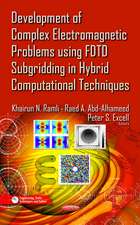Environmental Magnetism
Autor Roy Thompsonen Limba Engleză Paperback – 29 apr 2012
Preț: 384.86 lei
Nou
Puncte Express: 577
Preț estimativ în valută:
73.65€ • 76.61$ • 60.80£
73.65€ • 76.61$ • 60.80£
Carte tipărită la comandă
Livrare economică 14-28 aprilie
Preluare comenzi: 021 569.72.76
Specificații
ISBN-13: 9789401180382
ISBN-10: 9401180385
Pagini: 240
Ilustrații: XII, 228 p. 47 illus.
Dimensiuni: 155 x 235 x 17 mm
Greutate: 0.34 kg
Ediția:Softcover reprint of the original 1st ed. 1986
Editura: SPRINGER NETHERLANDS
Colecția Springer
Locul publicării:Dordrecht, Netherlands
ISBN-10: 9401180385
Pagini: 240
Ilustrații: XII, 228 p. 47 illus.
Dimensiuni: 155 x 235 x 17 mm
Greutate: 0.34 kg
Ediția:Softcover reprint of the original 1st ed. 1986
Editura: SPRINGER NETHERLANDS
Colecția Springer
Locul publicării:Dordrecht, Netherlands
Public țintă
ResearchCuprins
1 Introduction.- 2 Magnetic properties of solids.- 2.1 Introduction.- 2.2 Basic magnetic properties.- 2.3 Hysteresis.- 2.4 Effects of crystal size, shape and structure.- 2.5 Time dependence of magnetisation.- 2.6 Grain interactions.- 2.7 Summary.- Further reading.- 3 Natural magnetic minerals.- 3.1 Iron and its abundance.- 3.2 Iron oxides.- 3.3 Pyrrhotite and the iron sulphides.- 3.4 Iron hydroxides and oxyhydroxides.- 3.5 Other magnetic minerals.- 3.6 Formation of natural magnetic minerals.- 3.7 Summary.- Further reading.- 4 Magnetic properties of natural materials.- 4.1 Introduction.- 4.2 Units.- 4.3 Magnetic remanence.- 4.4 Magnetic susceptibility.- 4.5 Anisotropy of susceptibility.- 4.6 Magnetic hysteresis.- 4.7 General magnetic properties of natural materials.- 4.8 Temperature dependence of magnetic properties.- 4.9 Summary.- Further reading.- 5 The Earth’s magnetic field.- 5.1 Geomagnetism.- 5.2 Palaeomagnetism.- 5.3 Summary.- Further reading.- 6 Techniques of magnetic measurements.- 6.1 Introduction.- 6.2 Measurement of remanent magnetisation.- 6.3 Measurement of initial susceptibility.- 6.4 Measurement of induced magnetisation.- 6.5 Magnetic cleaning techniques.- 6.6 Magnetic fields.- 6.7 Portable instruments.- 6.8 A basic environmental magnetic kit.- 6.9 Summary.- Further reading.- 7 Magnetic minerals and environmental systems.- 7.1 Surface processes and magnetic minerals.- 7.2 Primary and secondary magnetic minerals.- 7.3 Magnetic minerals and material flux.- 7.4 Natural remanence and mineral magnetic properties.- 7.5 Sampling and measurement.- 7.6 Summary.- 8 Soil magnetism.- 8.1 Introduction.- 8.2 Magnetic properties of soil minerals.- 8.3 Weathering and magnetic properties.- 8.4 The magnetic enhancement of surface soils.- 8.5 Particle size relationships.-8.6 Some representative soil profiles.- 8.7 The effects of gleying on magnetic properties.- 8.8 Soil magnetism and slope processes.- 8.9 The persistence of magnetic oxides in the soil.- 8.10 Soil magnetism and archaeology.- 8.11 Conclusions.- 9 Magnetic minerals and fluvial processes.- 9.1 Introduction.- 9.2 Suspended sediment sources.- 9.3 Magnetic tagging and tracing of stream bedload.- 9.4 Magnetic measurements of stormwatersuspended solids.- 9.5 Conclusions.- 10 Mineral magnetic studies of lake sediments.- 10.1 Lake sediments and environmental reconstruction.- 10.2 The origin of magnetic minerals in lake sediments.- 10.3 Sampling and measurement.- 10.4 Prospecting, core correlation and sediment accumulation rates.- 10.5 Sediment resuspension and focusing.- 10.6 Sediment sources and ecological change.- 10.7 Magnetic measurements and fire.- 10.8 Lake sediment magnetism and climatic change.- 10.9 Summary and conclusions.- 11 Magnetic minerals in the atmosphere.- 11.1 Introduction.- 11.2 Sources of magnetic minerals in the atmosphere.- 11.3 Magnetic properties and aerosol modes.- 11.4 Magnetic-heavy metal linkages.- 11.5 Peat magnetism and the history of atmospheric particulate deposition.- 11.6 Contemporary particulate pollution monitoring.- 11.7 Magnetic particulates in ice and snow.- 11.8 Global dust studies.- 11.9 Summary and conclusions.- 12 Mineral magnetism in marine sediments.- 12.1 Introduction.- 12.2 The origin and flux of marine magnetic minerals.- 12.3 Core correlation in marine sediments.- 12.4 Mineral magnetism and palaeoclimate in deep-sea sediments.- 12.5 Particulate pollution monitoring in coastal waters.- 12.6 Summary and conclusions.- 13 Reversal magnetostratigraphy.- 13.1 Introduction.- 13.2 Geomagnetic signatures.- 13.3 The geomagnetic polarity timescale.- 13.4 Polarity transitions.- 13.5 Summary.- 14 Secular variation magnetostratigraphy.- 14.1 Introduction.- 14.2 Experimental methods.- 14.3 Magnetic dating and magnetostratigraphy.- 14.4 Origin of palaeolimnomagnetic secular variation.- 14.5 Palaeomagnetic pitfalls.- 14.6 Excursions and the reinforcement syndrome.- 14.7 Summary.- 15 Biomagnetism.- 15.1 Introduction.- 15.2 Magnetic navigation.- 15.3 Pneumomagnetism.- 15.4 Cardiomagnetism.- 15.5 Neuromagnetism.- 15.6 Summary.- 16 The Rhode River, Chesapeake Bay, an integrated catchment study.- 16.1 Physical setting.- 16.2 Sediment sources.- 16.3 Study aims.- 16.4 Methods.- 16.5 The magnetic mineralogy of the Rhode River catchment.- 16.6 Suspended sediment samples.- 16.7 Estuarine sediment cores: mineral magnetic characteristics.- 16.8 Chronology and links with land-use change.- 16.9 Summary and implications.- 17 Prospects.- 17.1 Palaeomagnetism of recent sediments.- 17.2 The mineral magnetic approach.- Glossary of magnetic terms.- References.












